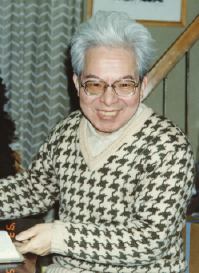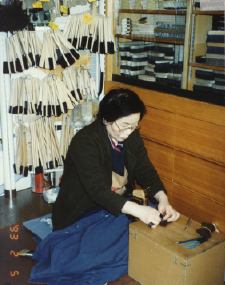Visit to ... Miyagawa-san, brush maker
Mr. Akio Miyagawa
Back we go again to Moto Asakusa, down the streets leading east from Ueno Station, first through the cluster of shops selling pachinko parlour supplies, then along the wide avenue past the dozens of shops selling Buddhist altars and household Shinto shrines ... We've been to this area twice before in this series of stories, once to see Shimano-san the woodblock planer, and then again to visit Kaneko-san, the bamboo skin supplier. This time my destination was the tiny hole-in-the-wall shop of Mr. Akio Miyagawa, the man who makes the brushes I use to spread pigments over the woodblocks.
 The shop is indeed tiny, and I think I can touch
both walls if I stretch my arms out. The space is made even smaller
by large cabinets and drawers stuffed with brushes of many types, and
just inside the door is a small raised platform where the work of
'sewing' the brushes together takes place. As I sit there today on
the edge of the platform and chat with Mr. Miyagawa, his wife Tsuyako
kneels beside me working on a small printmaker's brush. In front of
her is a wooden clamping arrangement gripping the piece of wood that
will become the body of the brush. This wood has been drilled with a
number of small holes, and she is now busy feeding a steel wire
through these one at a time, and tying small bundles of horsehair
tightly into place. When she is done, she will tack on a cover, trim
the hairs to length, and then soften the tips, so that it will be
ready for use by a waiting printmaker.
The shop is indeed tiny, and I think I can touch
both walls if I stretch my arms out. The space is made even smaller
by large cabinets and drawers stuffed with brushes of many types, and
just inside the door is a small raised platform where the work of
'sewing' the brushes together takes place. As I sit there today on
the edge of the platform and chat with Mr. Miyagawa, his wife Tsuyako
kneels beside me working on a small printmaker's brush. In front of
her is a wooden clamping arrangement gripping the piece of wood that
will become the body of the brush. This wood has been drilled with a
number of small holes, and she is now busy feeding a steel wire
through these one at a time, and tying small bundles of horsehair
tightly into place. When she is done, she will tack on a cover, trim
the hairs to length, and then soften the tips, so that it will be
ready for use by a waiting printmaker.
This type of work has been going on here on this little platform for about 70-odd years now, since the business was established back in the Taisho era. Perhaps you are surprised that I didn't say "...since back in the middle Edo period...". Well, businesses come and go as the times change, and even though Miyagawa-san's shop does not have an ancient history, he is recognized as one of the main suppliers of brushes for traditional craftsmen, and these men make up most of his customers. And they are not only woodblock printmakers. While we were chatting, we were interrupted by a couple of people asking if he had the special brushes for painting the faces of some 'bunraku' dolls they were making. His answer was not, "Yes", but rather, "What size would you like?" Of course he had them handy. He also has brushes for lacquer artists, Kamakura-bori style woodcarvers, Buddhist altar makers, kimono dye artists ... the list is endless. When I asked him how many types of brushes were here in the shop, he just shrugged his shoulders ... uncountable!
 There's quite a menagerie represented. Mundane
animals like horse, goat, badger, pig, sheep, etc., as well as the
more exotic (and expensive) such as sable. The hair comes from many
countries around the world, with the largest supplier being
China.
There's quite a menagerie represented. Mundane
animals like horse, goat, badger, pig, sheep, etc., as well as the
more exotic (and expensive) such as sable. The hair comes from many
countries around the world, with the largest supplier being
China.
The specialization in tools for traditional craftsmen is reflected in the way his brushes are measured. A hardware shop around the corner sells paintbrushes for carpenters sized by the centimeter. A brush I bought from Miyagawa san recently was described as 'ni sun go bu' (2 sun 5 bu). Are many of the readers of this newsletter old enough to remember that 10 'bu' make a 'sun', and 10 'sun' make a 'shaku'? (Perhaps Western readers who have learned simple numbers in Japanese will now realize just what the well-known word 'shakuhachi' means ...) Miyagawa-san sometimes receives orders for brushes with the body size expressed in 'sun', the hair length in centimeters, and the hole sizes in fractions of an inch!
Unlike most of the other craftsmen I have met, who work to their own schedule, the Miyagawas are tied to the daily rhythm of shop hours. There's only room for one person to work on the little platform in the shop, so the living space upstairs is also pressed into use. It's a true 'cottage' industry, except that here the cottage faces the four lane Asakusa-dori, with its never-ending stream of cars and trucks. But perhaps this is the most suitable environment for a traditional crafts shop. Back in the 'old days', this type of craftsman was always to be found right in the most densely populated part of town, in Shitamachi, surrounded by noise and activity. Not many of the truck drivers bother to glance in Miyagawa san's windows nowadays, but Tsuyako-san watches them go by as she sits working away on my next brush. Just as her predecessors watched the townsmen walk by on their way to Sensoji or the nearby Yoshiwara district. For this is where it all happened, those hundreds of years ago. And this is where it still happens, as long as people like the Miyagawas are willing to spend their time sitting on that narrow little platform, tying, tying, tying. And then occasionally looking up to answer, "Yes, of course. What size would you like ...." Mr. and Mrs. Miyagawa, thank you for your continuance of an old tradition ...

